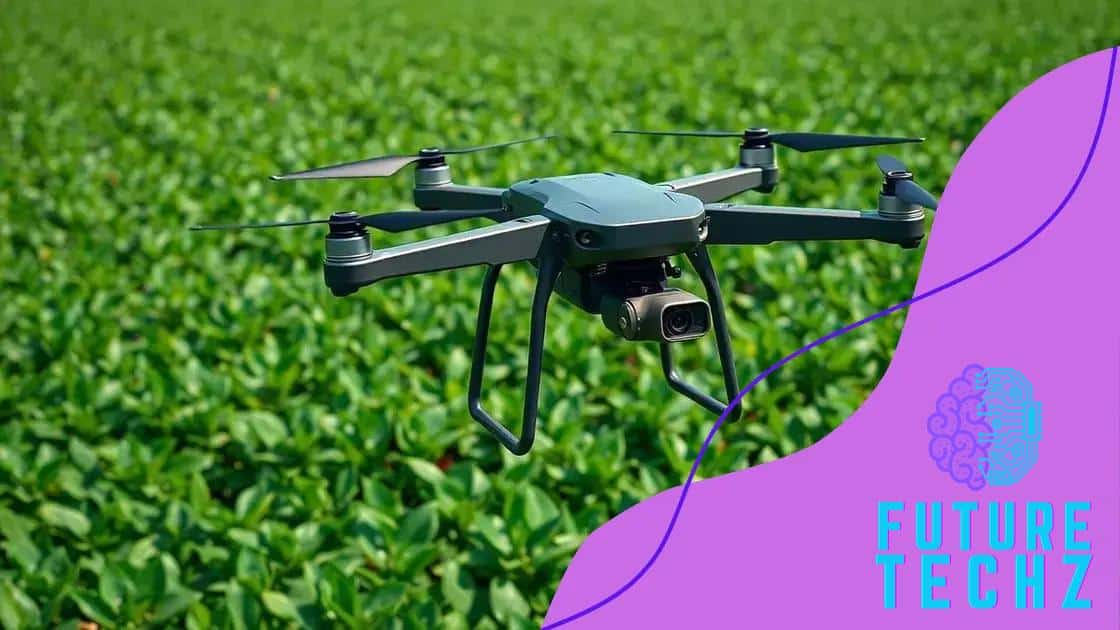Autonomous drones for agricultural monitoring: a game changer

Autonomous drones for agricultural monitoring enhance crop management by providing real-time data, improving efficiency, and allowing for precise interventions to boost yields and sustainability in farming practices.
Autonomous drones for agricultural monitoring are changing the way farmers manage their crops. By providing real-time data and insights, these drones offer a glimpse into the health of fields, helping optimize resources. Ever thought about how such technology might impact your farming practice?
Understanding the role of drones in agriculture
From monitoring crops to assessing soil conditions, drones play a pivotal role in modern agriculture. These autonomous drones are equipped with advanced technology that helps farmers make informed decisions.
How Drones Function in Agriculture
Utilizing aerial imagery, these drones can capture detailed information about various aspects of farming. By flying over fields, they provide real-time insights that can lead to better crop management.
- Crop health analysis through multispectral imaging
- Soil analysis for improved planting techniques
- Pest detection to reduce pesticide use
Additionally, the data gathered can significantly increase yields and decrease costs. Drones enable farmers to assess their fields in ways that were once time-consuming and labor-intensive. With the help of GPS technology, farmers can pinpoint problem areas accurately.
Benefits of Using Drones
The advantages of employing drones for agricultural purposes are numerous. For starters, the precision farming facilitated by autonomous drones allows for optimized resource use. This means less waste and better crop outputs. Furthermore, with aerial data, farmers are better equipped to anticipate weather changes and their impact on crops.
- Enhances decision-making with precise data
- Reduces labor costs by automating monitoring
- Improves overall sustainability practices
As these technologies evolve, their role in agriculture will likely increase. Farmers who adopt drones can expect not just immediate benefits but also long-term improvements in efficiency and productivity.
Benefits of using autonomous drones
The benefits of using autonomous drones in agriculture are significant and can transform farming practices. These drones bring efficiency and accuracy to various agricultural tasks.
Enhanced Data Collection
One major advantage is their ability to collect vast amounts of data quickly. Farmers can use this data to make informed decisions regarding crop management. By analyzing data from drone imagery, they can identify problem areas in their fields.
- Real-time monitoring of crop health
- Soil analysis for precise planting
- Pest detection for timely interventions
This immediate access to crucial information can help farmers respond proactively to issues, saving time and resources.
Cost Savings and Increased Yields
Utilizing autonomous drones can result in considerable cost savings. By optimizing pesticide and fertilizer use through targeted application, farmers minimize waste. This targeted approach not only cuts expenses but also enhances soil health.
Furthermore, with improved crop monitoring, farmers can achieve higher yields. Drones provide insights that allow for better crop management practices. By understanding field conditions in real time, farmers can ensure their crops receive the care they need.
As technology advances, the role of drones in agriculture will continue to grow, bringing even more benefits to farmers looking to optimize their operations.
How drones improve crop health monitoring

Drones have revolutionized how farmers approach crop health monitoring. With advanced imaging technology, these autonomous drones can identify issues in crops before they become severe.
Advanced Imaging Techniques
These drones use specialized cameras that capture images in various wavelengths. This allows farmers to see stress signs in plants that are invisible to the naked eye. By flying over fields, drones can quickly collect data that helps in understanding crop conditions.
- Multispectral imaging to assess plant health
- NIR (near-infrared) photography for identifying water stress
- Thermal imaging to detect temperature variations in crops
By employing these technologies, farmers can analyze crop health dynamically and efficiently. This capability helps them make timely interventions.
Real-Time Analytics
Another significant benefit of using drones is real-time data processing. Farmers can receive instant reports about their fields. This enables them to monitor changes in crop health throughout the growing season. Instead of waiting weeks for results from traditional soil and health tests, they can act promptly.
By identifying specific areas needing attention, farmers can allocate resources more effectively. This not only promotes healthier crops but also increases overall yields. Drones help create maps of crop health data, making it easier to visualize differences across fields.
Ultimately, the integration of drones in crop health monitoring provides farmers with tools to care for their crops more efficiently. As technology continues to improve, the potential for enhanced crop management grows, promising better food quality and yield.
Real-life applications of agricultural drones
Real-life applications of agricultural drones showcase their effectiveness and versatility. Farmers around the world are using these drones to enhance various aspects of their operations.
Precision Farming
One of the most popular uses for drones in agriculture is precision farming. This method involves using drones to gather data that helps farmers make informed decisions. By collecting detailed aerial images, farmers can assess crop conditions and understand field variability.
- Identifying nutrient deficiencies in areas of the field
- Monitoring irrigation needs based on moisture levels
- Analyzing pest infestations quickly to take action
This data allows for targeted applications of fertilizers and pesticides, improving overall efficiency and reducing waste.
Crop Health Monitoring
Drones also play a crucial role in monitoring the health of crops throughout the growing season. By utilizing specialized cameras, they can detect signs of stress before visible symptoms appear. This capability enables farmers to treat issues early, improving crop yield and quality.
The implementation of drone technology in crop health monitoring allows for quick assessments of larger areas than traditional methods. As a result, farmers can act faster and make better decisions based on real-time data.
Field Mapping and Surveying
Another significant application is field mapping and surveying. Drones create high-resolution maps of farm fields, which are vital for planning and analysis. This mapping provides a detailed overview of the land, helping farmers identify areas that need improvement or rehabilitation.
Additionally, these maps can be used for planning crop rotation and optimizing planting strategies, leading to sustainable farming practices. With the help of drones, farmers can better utilize their land and resources.
Overall, the real-life applications of agricultural drones demonstrate their impact on modern farming. As more farmers adopt this technology, we can expect to see further advancements in agricultural production.
Future trends in drone technology for farming
The future trends in drone technology for farming promise to bring even more advancements that can benefit farmers. As technology evolves, these trends aim to enhance efficiency, productivity, and sustainability in agriculture.
Integration with Artificial Intelligence
One major trend is the integration of artificial intelligence (AI)
This intelligent technology makes farming practices more precise and less labor-intensive. Another upcoming trend is the development of enhanced sensors that drones can carry. These advanced sensors provide better imaging capabilities, allowing farmers to monitor their fields more closely. With improved sensors, drones can detect problems earlier, leading to more timely interventions. Farmers will benefit from more accurate measurements of plant health, moisture levels, and nutrient content. This information enables them to respond proactively, optimizing their agricultural practices. The continued focus on precision agriculture will also influence drone technology. Farmers will increasingly rely on drones to gather detailed information and make informed decisions. By utilizing geographic information systems (GIS), drones can help create detailed mapping for effective planning. This approach not only boosts productivity but also promotes sustainability by ensuring resources are used efficiently. Thus, trends in drone technology are gradually shaping the future of farming. In summary, innovations such as AI integration, enhanced sensors, and precision agriculture will define the next generation of farming drones. These trends will help farmers meet the growing demand for food while managing resources responsibly. autonomous drones are reshaping the future of agriculture by providing innovative solutions for farmers. With their ability to collect real-time data, monitor crop health, and enhance precision farming, these drones help improve efficiency and sustainability. As technology continues to evolve, we can expect even more advanced applications that will support farmers in meeting the increasing demand for food while managing resources responsibly. The integration of artificial intelligence and advanced sensors will drive further adoption of drone technology, making farming smarter and more productive. Embracing these changes is essential for farmers looking to thrive in a competitive agricultural landscape. Drones provide real-time data and aerial imagery, allowing farmers to detect crop health issues quickly and accurately. Drones enhance efficiency, reduce costs, and increase yields by enabling precision farming and targeted resource application. Yes, the integration of AI helps drones analyze data in real-time, leading to smarter decision-making and improved agricultural practices. Most modern agricultural drones are designed to be user-friendly, with many having automated flight and data collection features that simplify operation.
Enhanced Sensor Technology
Drones in Precision Agriculture
FAQ – Frequently Asked Questions about Autonomous Drones in Agriculture
How do drones improve crop monitoring?
What are the benefits of using drones in farming?
Can drones be integrated with AI for better results?
Are drones easy to operate for farmers?





